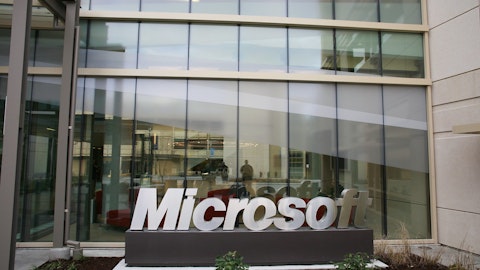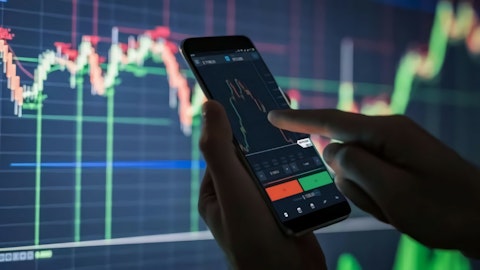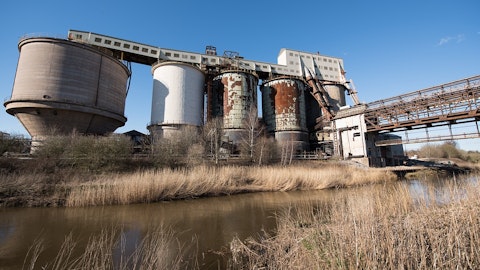Dow Inc. (NYSE:DOW) Q3 2023 Earnings Call Transcript October 24, 2023
Dow Inc. beats earnings expectations. Reported EPS is $0.48, expectations were $0.43.
Operator: Greetings, and welcome to the Dow Third Quarter 2023 Earnings Conference Call. [Operator Instructions] As a reminder, this conference is being recorded. I will now turn the call over to Dow Investor Relations, Vice President, Pankaj Gupta. Mr. Gupta, you may begin.
Pankaj Gupta: Good morning. Thank you for joining today. The accompanying slides are provided through this webcast and posted on our website. I’m Pankaj Gupta, Dow Investor Relations, Vice President; and joining me are Jim Fitterling, Dow’s Chair and Chief Executive Officer; and Howard Ungerleider, President and Chief Financial Officer. Please note our comments contain forward-looking statements and are subject to the related cautionary statements contained in the earnings news release and slides. Please refer to our public filings for further information about principal risks and uncertainties. Unless otherwise specified, all financials, where applicable, exclude significant items. We will also refer to non-GAAP measures. A reconciliation of the most directly comparable GAAP financial measure and other associated disclosures are contained in the earnings news release and slides that are posted on our website.

A technician working on an aerial view of a critical infrastructure, emphasizing the importance of the company’s utility services. Editorial photo for a financial news article. 8k. –ar 16:9
On Slide 2, you will see the agenda for our call. Jim will review our third quarter results and operating segment performance. Howard will provide an update on our cost savings actions and financial position and share our outlook and modeling guidance. To close, Jim will outline how our long-term growth and sustainability roadmap continues to enable value creation as we navigate challenging short-term dynamics. Following that, we will take your questions. Now let me turn the call over to Jim.
Jim Fitterling: Thank you, Pankaj. Beginning on Slide 3. For the third quarter, we continued to advance our long-term strategy while also taking action to reduce costs and maximize cash generation in the face of slow global macroeconomic activity and higher sequential feedstock costs. In particular, we continue to implement targeted actions to deliver $1 billion in cost savings in 2023 and delivered a sequential improvement to operating cash flow of more than $300 million. Net sales were $10.7 billion, down 24% versus the year ago period reflecting declines in all operating segments due to slower global macroeconomic activity. Sales were down 6% sequentially as volume gains were more than offset by lower local prices. Volume decreased 6% year-over-year, mainly due to lower merchant Hydrocarbons and Energy sales.
Volume was up 1% sequentially, led by gains in Industrial Intermediates & Infrastructure and Performance Materials & Coatings. Volume was up 3% sequentially, excluding merchant sales and Hydrocarbons & Energy with gains across all operating segments. Local price decreased 18% year-over-year with declines in all operating segments and regions, primarily due to lower feedstock and energy costs. Sequentially, price was down 7%, primarily in Europe, the Middle East, Africa and India or EMEAI. Operating EBIT for the quarter was $626 million, down from $1.2 billion in the year ago period and $885 million in the prior quarter. Our consistent focus on cash flow generation and working capital management enabled team Dow to generate cash flow from operations of $1.7 billion, resulting in a cash flow conversion of 129% for the quarter and 103% on a trailing 12-month basis.
We continue to invest in our long-term strategic priority while also returning $617 million to shareholders in the quarter through dividends and share repurchases. Year-to-date, we’ve returned nearly $2 billion to shareholders. Our cash flow generation continues to enable Dow to fully cover its capital allocation priorities. And our balance sheet remains the best it has been in four decades, supported by strong investment-grade credit ratings with no substantive long-term debt maturities due until 2027. Now turning to our operating segment performance on Slide 4. In the Packaging & Specialty Plastics segment, operating EBIT was $476 million compared to $785 million in the year ago period. Local price declines were driven by lower polyethylene and olefin prices in all regions, primarily as a result of lower global energy costs.
Volume declined as increased polyethylene demand across all regions was more than offset by lower volumes in merchant hydrocarbons and energy sales. Sequentially, operating EBIT decreased by $442 million, driven by lower integrated polyethylene margins, increased planned maintenance activity and lower licensing revenue. Moving to the Industrial Intermediates & Infrastructure segment, operating EBIT was $21 million compared to $167 million in the year ago period. Results were driven by lower prices and demand in both businesses as well as reduced supply availability due to an unplanned event in Industrial Solutions at our Louisiana operations. Sequentially, operating EBIT was up $56 million driven by volume gains and lower costs, which were partly offset by the Louisiana event.
And in the Performance Materials & Coatings segment, operating EBIT was $179 million compared to $302 million in the year ago period, driven by local price declines in both businesses. Volume was down as gains in commercial building and construction end markets were more than offset by lower demand for personal care and coatings applications and residential construction. Sequentially, operating EBIT increased $113 million, driven by higher operating rates and cost savings. Next, I’ll turn it over to Howard to review our outlook and actions on Slide 5.
Howard Ungerleider: Thank you, Jim. We expect the challenging macroeconomic dynamics to continue through the fourth quarter, including sluggish industrial activity. Global Manufacturing PMI has declined for the 13 consecutive month in September. It also includes weak demand in Europe and a slower-than-expected recovery in China. While inflation continues to moderate, it remains at elevated levels, resulting in a continuation of a tighter monetary policy. In the U.S., we’re seeing some mixed indicators as September manufacturing PMI improved to 49.8. Retail sales growth remains positive, while consumer confidence has declined for the last two months. In Europe, industrial and consumer demand remains weak despite sharply lower inflation.
PMI has contracted for 15 consecutive months through September, and consumer confidence remains low. With that said, automotive demand is showing signs of resilience. In China, while manufacturing PMI remained in expansionary territory in September, China exports fell for the fifth straight month. Automotive sales and production are a bright spot, rising in August, both sequentially and over the prior year in September. Around the rest of the world, India’s manufacturing PMI remains expansionary, while in Mexico, industrial production rose for more than 20 months in August. However, ASEAN manufacturing PMI contracted for the first time in two years in September. Against this macroeconomic backdrop, we will continue to take a disciplined approach to managing our operations while leveraging our diverse global portfolio and our cost-advantaged assets.
Turning to Slide 6. Our commitment to financial and operational discipline continues to be reflected in the proactive actions we are implementing to lower our costs and maximize cash flow. We achieved $700 million in cost savings year-to-date and remain on track to deliver our $1 billion commitment in 2023. In addition, we are further enhancing our financial flexibility as we execute on our capital allocation priorities across the economic cycle. For example, we’re implementing continued actions to improve our working capital to maximize cash flow. As a result, our cash conversion cycle has improved by approximately eight days from pre-COVID levels and we have unlocked approximately $600 million of cash from working capital in the third quarter.
Since Spin, we have taken actions to strengthen our balance sheet, ensuring ample liquidity while reducing net debt and pension liabilities, and we are continuing to take actions to further derisk our pension plans. Now pension-funded status has greatly improved, driven primarily by changes in the discount rate and the $1 billion voluntary contribution we made in 2021. Our decision to freeze the U.S. deferred benefit plans at year-end ’23 further reduced the pension liability. We expect to pursue additional derisking opportunities for our pension plans in the fourth quarter, including annuitization and risk transfer of some pension liabilities. If these transactions are executed, we expect to record a onetime noncash and nonoperating settlement charge in the range of $500 million to $1 billion in the fourth quarter of 2023.
All in, our targeted actions have given us the ability to continue investing in growth while delivering more than 80% of operating income back to our shareholders, well above our 65% target. Turning to our outlook for the fourth quarter on Slide 7. In the Packaging & Specialty Plastics segment, industry data shows a continued decline in U.S. Gulf Coast inventory levels driven by resilient domestic demand and export market strength. Higher polyethylene prices and elevated oil to gas spreads continue to favor our cost advantaged footprint and are expected to generate $100 million tailwind in the quarter. Additionally, we expect a $25 million tailwind as we complete planned maintenance activity at our cracker in St. Charles, Louisiana. We also expect a $50 million headwind to equity earnings due to a planned turnaround at our joint venture in Thailand.
In the Industrial Intermediates & Infrastructure segment, we expect seasonal demand increases in deicing fluid to offset seasonal volume declines in building and construction end markets. Additionally, we expect a headwind of $25 million due to elevated energy and feedstock costs, particularly in Europe impacting our polyurethanes and our construction chemicals businesses. In the Performance Materials & Coatings segment, we expect the current macroeconomic conditions to limit consumer discretionary spending in nonservice areas. We also expect margin pressure to continue in upstream siloxanes from competitive supply additions, which will result in a $25 million headwind. Additionally, the seasonal decline in building and construction demand is expected to contribute an approximately $50 million headwind in the quarter.
All in, we expect fourth quarter earnings to be in line with the third quarter. Next, I’ll turn it back to Jim.
Jim Fitterling: Thank you, Howard. Moving to Slide 8. We continue to make progress on both our Decarbonize and Grow, and Transform the Waste strategies which by 2030, position us to deliver more than $3 billion in underlying earnings while reducing greenhouse gas emissions by 5 million metric tons and commercializing 3 million metric tons of circular and renewable solutions annually. Starting with decarbonize and grow. In September, we achieved startup of a new MDI distillation and pre-polymer facility at our manufacturing site in Freeport, Texas. This new facility replaces Dow’s existing capacity in La Porte, Texas, and expand supply by an additional 30% at the site to support high-value demand growth in polyurethane systems while also reducing our greenhouse gas emissions by more than 45% compared to the La Porte asset.
Our Path2Zero project in Alberta remains on track. We expect the final investment decision by year-end, pending completion of our subsidies and incentives with the Canadian federal government. Additionally, we recently announced a solar power purchase agreement with MSU Green Energy in Bahía Blanca, Argentina, which will drive the site to source 75% of its electric power supply from renewable sources by 2025. In Terneuzen, the Dutch government informed us that they need more time for adjustments to certain rules and regulations critical to enabling carbon capture and clean hydrogen. The public private partnership is a crucial element of our Path2Zero effort at Terneuzen. Dow investment and timing will depend on the level of collaboration, subsidies available and a clear regulatory framework.
We will continue to engage with the Dutch government to advance these efforts. And we continue to advance our Transform the Waste strategy, in the third quarter, we successfully leveraged our U.S. Gulf Coast assets for bio and circular feedstock processing, accomplishing a key milestone to utilize existing assets to quickly scale production of recycled and bio-based products. This was a direct enabler to the commercial launch of our sustainable Surlyn ionomers, which support high-end applications like perfume and cosmetics packaging. In addition, Valoregen in France and Mura technology in the U.K. remain on track to start up their respective mechanical and advanced recycling facilities by year-end. All in, we expect that our initiatives to develop a circular ecosystem will generate more than $500 million of incremental run rate EBITDA by 2030.
Altogether, we remain confident in our long-term growth with continued focus on a more sustainable future while maintaining a disciplined and balanced approach to capital allocation. Next, an update on our Path2Zero project in Fort Saskatchewan, Alberta, on Slide 9. The project will enable Dow to capture sustainable growth opportunities while also delivering on our 2030 greenhouse gas emissions reduction targets and advancing our long-term goal of carbon neutrality by 2050. Construction is planned to begin next year with Phase 1 start-up expected in 2027 and Phase 2 expected in 2029. We expect to spend an average of $1 billion of CapEx annually on this key growth project with total enterprise CapEx ramping above depreciation and amortization levels in the 2025 to 2027 time period as we implement the first pad.
We remain fully committed to keeping our CapEx within DNA across the economic cycle and expect to return to those levels as we complete the project. We are expecting bottom line returns on our Alberta Path2Zero project equal to or better than our Texas 9 investment. Turning to Slide 10. We are partnering with brand owners and leaders across the value chain to strategically enable and scale waste management transformation through mechanical recycling, advanced recycling and bio-based solutions. This allows us to lead the way to a more circular economy and become a major off-taker of circular feedstock while also minimizing capital outlay for Dow. Robust industry demand for these solutions is expected to outpace supply through the end of this decade.
We expect Dow’s differentiated innovation portfolio to create opportunities that will result in more than $500 million in incremental earnings by 2030. Continuing on Slide 11. Our actions to commercialize 3 million metric tons of circular and renewable solutions annually are driven by a robust pipeline of strategic partnerships. These collaborations enable us to deliver innovative solutions to meet increasing brand owner demand. For example, our partnership with P&G China to enable recyclability of air capsule e-commerce packaging delivers an effective and efficient way to protect products while avoiding excessive packaging. Dow’s SPECFLEX CIR foam system uses recycled waste from the automotive industry to produce circular polyurethane-based materials matching the performance of existing products as seen in the recent launch of the Mercedes-Benz E-Class and our collaboration with LVMH Beauty is pioneering circular feedstocks for sustainable packaging and the cosmetics industry.
This has enabled Dow’s first sales of bio-based and advanced recycling polymers in the third quarter. Closing on Slide 12. Since Spin, we have executed against our strategic priority and consistently demonstrated financial and operational discipline. As a result of our proactive actions, our underlying earnings and cash flow generations are well above pre-COVID levels, and our balance sheet is the strongest it’s ever been, especially in this part of the cycle. Our global scale and leading positions across key value chains paired with our cost-advantaged assets and industry-leading feedstock flexibility positioned Dow well to respond quickly to evolving market trends and capture above GDP demand growth across our attractive market verticals.
These distinct competitive advantages will continue to enable us to execute our capital allocation priorities while also driving long-term value growth for our shareholders. Finally, before we move to Q&A, I would like to speak to the announcement this morning that Howard is elected to retire from the company following 33 years of dedicated service. I want to personally thank Howard for his significant contributions to Dow over the last three decades. He’s been an incredible business and strategic partner, created a financial and leadership team that guided our company through numerous challenges and accomplishments and most importantly, he’s been a tremendous colleague and friend. In addition to recognizing and thanking Howard, we are pleased to share that the Board has elected Jeff Tate to the role of CFO effective November 1, 2023.
As we thank Howard for his years of service and there will be time to honor and recognize him for that. We’re excited to welcome Jeff back to Dow. Many of you will remember, Jeff, who also previously led Dow’s Investor Relations team. He returns to us following a 4-year stint as the CFO of Leggett & Platt. Prior to that, Jeff had 27 years with Dow in various finance roles, including VP of Finance for Packaging and Specialty Plastics and was our lead auditor. Jeff is joining us here today, and we’ll look forward to him joining our next earnings call in his formal role. In the meantime, more to follow as we all work together through this transition. As I noted, this change will become effective November 1, and Howard will stay on to support the handover through early January when he will formally retire from Dow.
Howard, I’ll now turn the mic over to you for a few comments.
Howard Ungerleider: Thank you, Jim. I really appreciate those comments and thoughts. And I would like to share a few personal thoughts of my own. I’ve had the good fortune of being Dow’s CFO for nearly a decade and President for the last five and they have truly been the best roles of my career. Jim it was an absolute honor to serve with you and the rest of the leadership team. We have accomplished a great deal together and I am extremely proud of not only what we have delivered for all of our stakeholders, but also how we have done it. Dow is a great company. Our decarbonizing growth strategy is absolutely the right path forward and our balance sheet, as you’ve said, is in the best shape it’s been in four decades, and that’s as a direct result of our disciplined and balanced capital allocation approach.
The Dow culture and the incredibly smart hard-working people who embrace it each and every day all over the world are absolutely second to none. After more than 33 years at Dow, this is the right moment for me to move on to my next chapter, and I could not be more excited to hand the finance reins over to Jeff Tate. Jeff and I have known each other for more than 25 years. We have worked alongside each other, and I consider him to be a great professional as well as a friend, and he is absolutely the right leader to help take down to the next level of performance together with Jim and the leadership team. And while I’m retiring from Dow, I am not heading to the beach of the golf course, I’m excited about my next chapter and the opportunities that lie ahead.
With that said, I believe Dow Red, PANTONE 185 for those of you checking the color wheel, and I will always be a supporter a fan and a friend of Team Dow. With that, I’ll turn it to Pankaj to open the Q&A.
Pankaj Gupta: Thank you, Howard. Now let’s move on to your questions. I would like to remind you that our forward-looking statements apply to both our prepared remarks and the following Q&A. Operator, please provide the Q&A instructions.
See also 40 Awesome Places to Retire on $3,000 a Month or Less and Top 15 Tech Trends In 2023.
Q&A Session
Follow Dow Chemical (Old Filings) (INDEXDJX:DOW)
Follow Dow Chemical (Old Filings) (INDEXDJX:DOW)
Operator: [Operator Instructions] Your first question comes from the line of Hassan Ahmed of Alembic Global. Your line is open.
Hassan Ahmed: Good morning Howard and Jim. Howard, sorry to see you leave. But obviously, wishing you the best wishes for your future sort of endeavors. In terms of my question, you guys obviously talked about $100 million worth of tailwind — EBIT tailwind on the P&SP side of things. And you cited expanding oil to natural gas ratios. I just want to sort of delve a little deeper into that. What sort of pricing regime for polyethylene are you baking into that? What sort of pricing regime for ethane are you baking into that?
Jim Fitterling: Good morning, Hassan. Yes. As we mentioned, we guided for the fourth quarter, in line with the third quarter. It will obviously be a different mix. I expect packaging especially plastics to be up. They had obviously, the weight of the St. Charles turnaround on them in the third quarter. And they also had the fact that we were out of the merchant ethylene market. When you look at the core underlying volumes, polyethylene volumes were up in all regions year-over-year, and they were up sequentially 3% in Asia, Latin America and EMEA. So those are good signs. Things that you should take into account is we obviously don’t have the St. Charles turnaround in the fourth quarter. We do have a little bit of a headwind from the Thailand turnaround.
We’re expecting — we saw prices up in September. I’m expecting Q4 integrated margins to be up about $0.02 in P&SP, and that’s mostly on the back of pricing. The outlook right now is for ethane to be flat. It could be slightly better than that. But I think for right now, we’ve got it in as flat. We’ve got inventories down for three consecutive quarters in the United States and plastics, and U.S. Gulf Coast exports were up 7% versus the previous quarter and the previous quarter was up about 3.5% versus a quarter before. So I think all in all, I would expect volumes to be good, we’ll be back in the merchant ethylene market for some extent. Pro-Nap spread in Europe is positive at about $120 a ton, and our assets are the lowest cost in Europe. And I think when you factor all that in, the guide for the fourth quarter is heavily on the back of P&SP fee delivery.
Operator: Your next question comes from the line of David Begleiter of Deutsche Bank. Your line is open.
David Begleiter: Thank you. Again, Howard has been an absolute pleasure and best of luck. Jim, Howard, second half EBITDA is running around $5 billion annualized, maybe a little bit more than that. How do you grow — if the macro stays the same as it is today, how does EBITDA increase materially next year?
Jim Fitterling: Good morning, David. Good question. Obviously, we’re about 12 to 15 months into this economic slowdown, and typically, when we see a slowdown like we saw starting mid last year, about 12 to 18 months, we start to see things turn to a positive direction. Inflation is the thing that’s weighing on people’s minds right now. We’re continuing to invest in our organic growth, while at the same time, manage our costs. We’ve got investments in all three segments, both incremental investments as well as new plant investments. They will start up through this year. This year, we expect those add an underlying $400 million to $500 million of EBITDA mid-cycle run rate to the bottom line. On top of that, we’re continuing to see strength in areas like telecommunications and data centers, automotive, even in the face of the strikes is holding up relatively well.
And our view is that it should bounce back once the agreements are made between the UAW and the auto workers. Our cost positions are good. And so I think that we’re positioned that once the weight of inflation starts to moderate that things start to turn back in a positive direction. And our view is that we could be in a better shape for 2024. Additionally, we’ve taken $1 billion of cost out since Spin. So if you think about where we’re operating today, we’re able to meet all of our capital allocation requirements, be free cash flow before financing breakeven, you saw a $300 million improvement this quarter in operating cash flows, and we were still able to opportunistically buy back some shares in the third quarter. So we’ve done our best to really manage to be able to get through the bottom of the cycle, and it’s the right time for us to continue to make organic investments to get the benefit in the next up cycle.
Howard Ungerleider: And David, this is Howard. Look, thanks for your comments, Hassan, same to you as well. The only other thing I would add, David, to your question is don’t forget about cash, right? So I mean Jim laid out our EBITDA or EBITDA improvements, but we have equally been doing cash flow improvements really every year since Spin, if you think about it. So the last five or six years, every year, we’ve been able to increase cash flow. We’ll see if we can do that this year. But a couple of things. We are able to cover all of our capital allocation priorities inclusive of continuing to buy stock back even at these low EBITDA levels. And every year, we’ve had between $1 billion and $3 billion of what we like to call unique to Dow cash levers.
And I would expect that to continue into next year. When you think about the $500 million plus judgment that we will likely get finally from Nova on the last tranche, continued structural working capital improvements, additional cash that we can pursue out of our joint ventures, and other projects that we currently have in the pipeline. So you should expect at least another $1 billion of unique to Dow cash flow levers coming out of next year on top of the organic investments that Jim talked about.
Operator: Your next question comes from the line of Vincent Andrews of Morgan Stanley. Your line is open.
Vincent Andrews: Thank you. And let me also echo the prior remarks and congratulations to you, Howard. Very exciting for you. If I could ask just looking at Slide 9 on the CapEx. I just want to make sure I understand — I mean, obviously, we know where ’23 is, it looks like ’24 is going to go to that D&A line. And then that ’25 to ’27, it looks like there’s quite a — there’s sort of a zone there. Could you speak to a little bit of maybe a range that you could give us to make sure we have that right in our models and sort of what would define it at the lower end or the upper end of the range? Because I see you do have Alberta at about $1 billion a year, but is it maybe going to be a bit chunkier in some of those years? Or just how should we be thinking about the cadence and the range of CapEx during that period of time.
Jim Fitterling: Hi, good morning. Vince, yes, as we get into the Alberta project, it will be ’25 to ’27 that is the peak construction of that project. Phase 1 starts up in ’27. You would expect that we would get to somewhere in the 3 to 3.5 range for CapEx during that ’25 to ’27 time frame. That’s very similar to where we were during the Gulfstream project, we peaked at kind of that same level. Obviously, we’re in a little bit different spot than we were at Gulfstream. We’re just doing Alberta Path2Zero, but we’re also funding growth in Industrial Solutions, which is high-value growth and downstream incremental growth in our Consumer Solutions business. So, I think it will be very manageable. And as we get closer to those dates, we’ll try to titrate more specifically, so that you have some year-over-year expectations on what CapEx is going to look like.
Operator: Thank you. Your next question comes from the line of Jeff Zekauskas of JPMorgan. Your line is open.
Jeff Zekauskas: Thanks very much. In your $1 billion cost-cutting program, how much of that comes out of SG&A and R&D? And in your slides, you say that your share count in the fourth quarter is 7.10 and in the third quarter, it was7 or 7.5. Are you rounding or is the share count going up?
Jim Fitterling: Yes, Jeff, good morning. On the cost, about half of the costs come out of our structural operating cost model, which would include obviously, making sure that we’re controlling SG&A, during this time period. It also includes things like contract labor and what we’ve been doing, there to reduced headcount. On our operating cost side, it’s things like purchase raw material and logistics costs, utilities costs being down, our turnaround spend, which is down about $300 million. And while SG&A is down both in cost and as a percent of sales, we’re obviously still continuing to invest in research as we go forward. Howard, do you want to touch on the share count?
Howard Ungerleider: Yes, Jeff, I was smiling. So yes, it is just purely rounding. The share count actually went down about 2 million shares quarter-on-quarter. Year-on-year, it went down 11 million shares. And I would say two things. We are going to continue as long as we have the free cash flow before financing to continue to buy at dilution. And we will also continue to be opportunistic when we have cash available and/or we believe it’s a great investment. And so, we’re continuing to buy shares on a regular basis, and you should expect that to continue in the fourth quarter.




